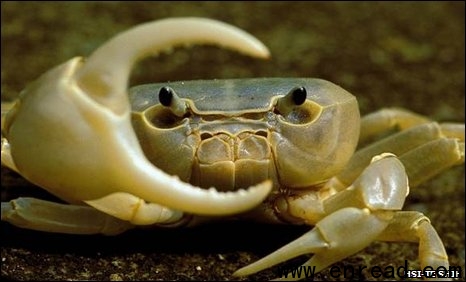| ||||||||||||||||||||||||||||||||||||||||||||||||||||||||||||||||||||||||||||||||||||||||||||||||||||||||||||||||||||||||||||||||||||||||||||||||||||||||
|
Two thirds of all species of freshwater crab1 maybe at risk of going extinct, with one in six species particularly vulnerable, according to a new survey. 一项新调查显示,所有种类的淡水蟹有三分之二面临绝迹,其中六分之一特别容易受到伤害。  Geothelphusa ancyclophallus has little defence against habitat destruction That makes freshwater crabs2 among the most threatened of all groups of animals assessed(估定值) so far. The study is the first global assessment3 of the extinction4 risk for any group of freshwater invertebrates5(无脊椎动物). Crab species in southeast Asia are the most at risk, from habitat destruction, pollution and drainage(排水系统). Scientists from the Zoological Society of London and Northern Michigan University led the survey, which produced the first World Conservation Union (IUCN) Red List assessment of the 1280 known species of freshwater crab. Of those, the survey found that 227 species should be considered as near threatened, vulnerable(易受伤害的,有弱点的), endangered or critically endangered. For another 628 species, not enough data exists to adequately assess their future, says the survey published in the journal Biological Conservation. However, while the most optimistic scenario6(情节,剧本) is that 16% of all species are at risk, the worst case scenario suggests the figure could be as high as 65%, or two-thirds of all species. Keystone species Freshwater crabs are essential to many freshwater ecosystems7. Some feed on fallen leaves and algae8(水藻,海藻), while other species help cycle nutrients10 by eating vast quantities of detritus(碎石,碎屑). The crabs themselves are an important source of food for a range of birds such as herons(苍鹭) and kingfishers(翠鸟), reptiles11(爬行动物) such as monitor lizards12 and crocodiles and amphibians13(两栖类) such as frogs and toads14(蟾蜍). Mammals that like to dine on(吃) freshwater crabs include otters15(水獭), mongooses(猫鼬), civets(麝猫) as well as wild boar(野猪) and even macaque(短尾猿) monkeys. Because most species require pristine16(原来的,古时的) water to survive, they are also excellent indicators17 of good water quality. But species are increasingly being impacted by habitat destruction and pollution. Most vulnerable are crabs living in southeast Asia, which is also home to the greatest diversity of species. For example, 40 of 50 species living in Sri Lanka are threatened. Those species that live a semi-terrestrial life, breathing air, living in burrows18(地洞) and dividing their time between water and land, appear most at risk, possibly because their habitats are most easily disturbed by human activities. No species are yet known to have gone extinct, but some species such as the terrestrial crab Thaipotamon siamese and the waterfall crab Demanietta manii from Thailand have not been seen alive for over a century, and their original habitats have since been built over by urban developments. The loss of natural forest to land development and agriculture has also impacted almost every habitat in which freshwater crabs live, the report notes. The proportion of freshwater crabs threatened with extinction is equal to that of reef-building corals, and exceeds that of all other groups that have been assessed except for amphibians. "We must set clear goals to reverse these trends and ensure that our enduring legacy19(遗赠物) is not to wipe out the small things that provide us with great benefits, such as nutrient9 cycling," says Ben Collen, one the survey scientists from the Zoological Society of London. 点击  收听单词发音 收听单词发音
|
||||||||||||||||||||||||||||||||||||||||||||||||||||||||||||||||||||||||||||||||||||||||||||||||||||||||||||||||||||||||||||||||||||||||||||||||||||||||
- 发表评论
-
- 最新评论 进入详细评论页>>



